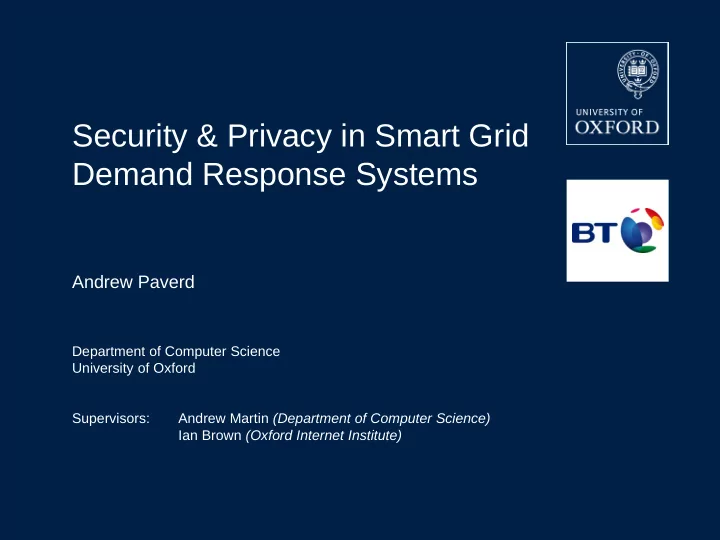

Security & Privacy in Smart Grid Demand Response Systems Andrew Paverd Department of Computer Science University of Oxford Supervisors: Andrew Martin (Department of Computer Science) Ian Brown (Oxford Internet Institute)
Objectives Highlight security and privacy issues Different from smart metering – Build on existing research Work by M. Karwe and J. Strüker (SmartGridSec 2012) – Encourage further research
Overview What are the main security and privacy challenges in demand response systems? Demand Response Systems Security & Privacy Goals Adversary Models Analysis of OpenADR Proposed Solution
Demand Response Systems Security & Privacy Goals Adversary Models Analysis of OpenADR Proposed Solution
Demand Response (DR) Dynamically reducing energy demand at specific times and in specific locations… Price-based Incentive-based • Time of use (ToU) pricing • Consumers bid to reduce or shift demand • Critical peak pricing • Financial incentives • Dynamic pricing • Bidding protocol (bidding • In-home display or energy agents and manager) management system
Incentive-Based DR
OpenADR 2.0 Communication data model for DR systems Enables price-based and/or incentive-based DR – XML data over IP network – Medium independent (wireless, power line communication etc.) HTTP, SOAP and XMPP – Hierarchical structure Virtual top node (VTN) and virtual end nodes (VEN) – Demand Response Automation Server (DRAS) Automate communication between entities –
OpenADR 2.0 Source: OpenADR Alliance: The OpenADR Primer (2012)
OpenADR 2.0
Demand Response Systems Security & Privacy Goals Adversary Models Analysis of OpenADR Proposed Solution
Security Goals Primary security objective: Only legitimate entities participate in the DR protocol Security Goal 1 Consumers must be able to verify the authenticity and integrity of all DR events. Security Goal 2 The DR manager must be able to verify the authenticity and integrity of all DR bids.
Privacy Goals * Based on work by M. Karwe and J. Strüker Primary privacy goal: Protect the privacy of individual consumers Privacy Goal 1 Untrusted entities must not be able to link DR bids to individual consumers. Privacy Goal 2 Untrusted entities must not be able to infer private information about individual consumers from the DR system.
Demand Response Systems Security & Privacy Goals Adversary Models Analysis of OpenADR Proposed Solution
Adversary Models * Based on AMI security & privacy research Dolev-Yao (D-Y) Strongest possible adversary – Passive: eavesdrop or intercept messages – Active: block, modify, replay or synthesize messages – – Cannot break cryptographic primitives Honest-But-Curious (HBC) More limited than D-Y adversary – – Always follows protocol Cannot break cryptographic primitives – Attempts to learn/infer/deduce sensitive information –
Demand Response Systems Security & Privacy Goals Adversary Models Analysis of OpenADR Proposed Solution
Adversary Model for OpenADR Source: OpenADR Alliance: The OpenADR Primer (2012)
Adversary Model for OpenADR Adapted from: OpenADR Alliance: The OpenADR Primer (2012)
External D-Y Adversary Goal Potential attack Mitigation S-1 Modify messages TLS (integrity) S-2 (e.g. change bid amount) S-1 Falsify messages TLS (mutual authentication) S-2 (e.g. falsify bids) P-1 Eavesdrop on messages to learn TLS (confidentiality) P-2 private information P-1 Traffic analysis Dummy traffic (permitted by P-2 (e.g. measure encrypted traffic) specification) Specification satisfies all security and privacy goals ● * Assuming no compromised keys
Consumer as a D-Y Adversary Goal Potential attack Mitigation S-2 Falsify messages Detected by service provider (e.g. falsify bids) (TLS mutual authentication makes consumer uniquely identifiable) S-2 Masquerade as other consumers TLS mutual authentication makes consumer uniquely identifiable Specification satisfies all security goals ● * Assuming no compromised keys Privacy goals as before
DRAS as an HBC Adversary Goal Potential attack Mitigated using P-1 Link bids to individual consumers End-to-end encryption between consumer and utility (Karwe & Strüker) P-2 Infer private information from the End-to-end encryption received bids between consumer and utility (Karwe & Strüker) Security goals not applicable (HBC adversary) Privacy goals not satisfied by OpenADR specification Require additional mechanisms –
Utility/Supplier as an HBC Adversary Goal Potential attack Mitigated using P-1 Link bids to individual consumers ? P-2 Infer private information from the ? received bids Privacy goals not satisfied by OpenADR specification Require further research – Conflict between privacy and security goals TLS mutual authentication allows utility to detect masquerading but – ensures that utility will be able to link bids to consumers
Adversary Model for OpenADR Adapted from: OpenADR Alliance: The OpenADR Primer (2012)
Demand Response Systems Security & Privacy Goals Adversary Models Analysis of OpenADR Proposed Solution
Trustworthy Remote Entity (TRE) Trusted third-party Intermediary between consumers and external entities – Information processing (aggregation, perturbation, etc.) – Utilizing Trusted Computing Secure/measured boot – Remote attestation of system state – Minimal trusted computing base – Isolated execution environment – Multiple TREs in the grid Multiple redundancy – Load balancing –
Proposed Architecture
Conclusions DR is an important aspect of the future smart grid Specific DR security and privacy goals In addition to smart metering goals – Various adversary models Multiple sources of threats Must be addressed before wide-scale deployment – Proposed solution Opportunities for further research –
Security & Privacy in Smart Grid Demand Response Systems Andrew Paverd Department of Computer Science University of Oxford Supervisors: Andrew Martin (Department of Computer Science) Ian Brown (Oxford Internet Institute)
Recommend
More recommend